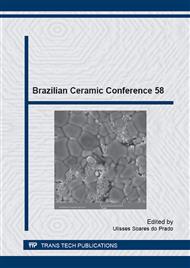p.193
p.199
p.205
p.213
p.218
p.225
p.231
p.239
p.244
Curvature Evolution of Porcelain Tile during Firing
Abstract:
Planarity is one of indispensable attribute of a ceramic tile quality. During the firing changes on curvature may be permanent causing damage on quality and productivity. The objective was to evaluate curvature evolution on porcelain tile during heating stage of firing. Effects of engobe and glaze coating were evaluated. The performance of two compositions of porcelain tile was studied on industrial (1000 mm x 500 mm x 10 mm) and laboratorial (100 mm x 50 mm x 6 mm) scale. Industrial test pieces were fired at 950 and 1200 °C. Final curvature was measured by conventional dial indicator. Curvature evolution of laboratorial test pieces was evaluated by thermal fleximetry from 25 to 1200 °C. This characterization was capable to identify very significant positive curvature deflection on temperature range from 930 to 1200 °C, directly associated to permanent planarity defects. Differences on composition affect significantly the curvature evolution.
Info:
Periodical:
Pages:
218-224
Citation:
Online since:
June 2015
Authors:
Price:
Сopyright:
© 2015 Trans Tech Publications Ltd. All Rights Reserved
Share:
Citation:


